Responsible approach to selection: what is the heat output of steel heating radiators? Characteristics table
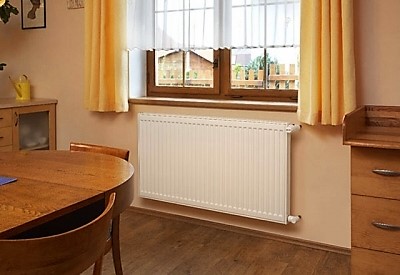
Steel radiator is a rectangular panel consisting of welded steel sheets, on which special recesses are stamped. When welding, they form channels, necessary for the circulation of the coolant.
In order to choose the right radiator for your heating system, you need to know them Main technical characteristicsOtherwise, you may get a result that is completely opposite to what you want.
Steel heating radiators
Steel is distinguished by such parameters as: strength, flexibility and plasticity, which is especially important in welding work. In addition, such metal conducts heat well, so its use in the manufacture of heating batteries is quite justified.
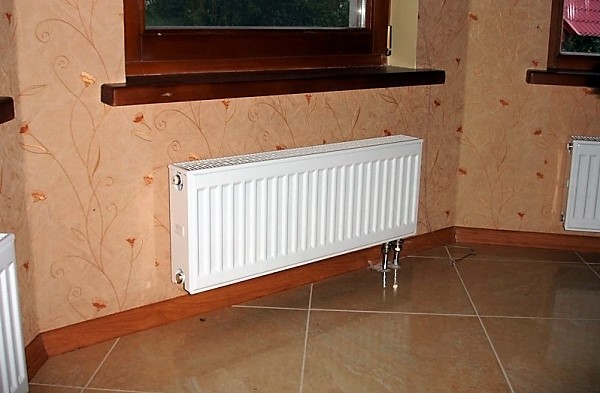
Photo 1. Steel panel radiator installed under the window, with a lower connection type of the heating system.
Technical specifications: power table
| Characteristics | Name of units |
| Heat dissipation | 1200 to 1800 watts |
| Working pressure | from 6 to 10 atmospheres |
| Coolant temperature | from 110 to 120 °C |
| Center distance | How height radiator minus 50 - 70 cm. In tubular - from 120 mm to 2930 mm. |
| Dimensions | Length up to 3 meters, height from 20 to 90 centimeters |
| Thickness of steel | from 1.15 to 1.25 mm. |
| Durability | up to 50 years |
Dimensions of panel and tubular
Steel radiators can be two types:
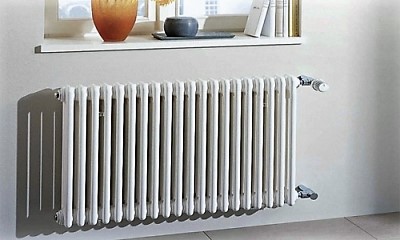
- Tubular. The battery consists of several steel pipes, welded together. The design of the product is such that it is possible to come up with various shapes for the radiator, so this option is considered more expensive.
- Panel. Products may include from 1 to 3 panels, each of which consists of two flat profiles. The plates have vertical channels, which are paths for the coolant. This production option is distinguished with the least cost.
As for the dimensions, panel radiators may have length up to 3 meters. Height can be from 200 to 900 mm.
Tubular models, in theory, can be absolutely any length, but their depth is limited 22.5 cm. Height can be from 190 to 3000 mm.
Heat transfer level
As practice shows, the heat transfer rate of steel radiators can be from 1200 to 1800 W. The spread is quite large, which is explained by different dimensions products, brand manufacturer and model radiator.
Important! One of the distinctive features of steel radiators is the fact that they heat up very quickly, after which they begin to gradually heat the room.
Working pressure
This indicator depends on the type radiator. For lamellar radiators this value fluctuates from 6 to 10 atmospheres. U tubular products this figure is slightly higher - up to 15 atmospheresBut even these values are not enough to use steel batteries in apartment buildings with a common heating system.
Volume and temperature of water or other coolant
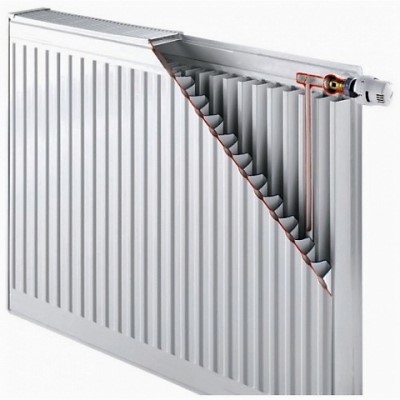
In this case, steel is not the best option, because water exposure for her it is simple destructive.
Of course, manufacturers are trying their best to solve this problem by coming up with various protective coatings, but it often happens that the situation does not change.
That's why if you live in a multi-story building, then steel radiators will not be the best option for you. The fact is that with the arrival of warmth, the water is drained from the batteries, which can lead to the appearance of rust.
Steel batteries, regardless of their type, can withstand water temperatures up to 120 degrees Celsius. Volume liquid that the device holds, depends on its dimensionsAs a rule, the device's passport indicates how many liters it can effectively heat.
Center distance
The center distance is the difference in the location of the upper and lower collectors. This indicator will vary depending on the type of radiator:
- Panel models. Center distance equals the height the radiator itself minus 50-70 centimeters.
- Tubular. In this case, the parameter is from 12 to 293 centimeters.
Important! Radiators made of steel can have different types of connection - bottom and side. The center distance indicator is important only if steel radiators have side connection.
Thickness
Many buyers simply do not pay attention to this parameter, which is completely wrong. It is obvious that the thicker the steel, the better for its further operation. Depending on the manufacturer, this parameter may be from 1.15 to 1.25 mm.
Service life
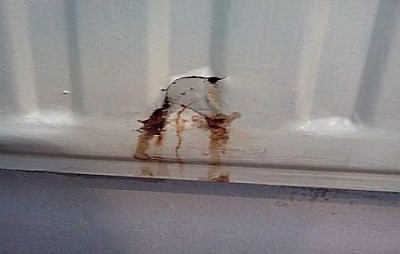
Steel is one of the most reliable materials, capable of serving for many years. Of course, if it is not exposed to various harmful factors, such as corrosionThe same applies to heating batteries.
Service life May be higher, if the radiators have sufficient thick walls - about 1.3 mm. Such products are produced by well-known brands that are responsible for the quality of their products. Average term operation, if the working pressure standards are observed, is 20 years.
Easy to install
Steel radiators are distinguished by a fairly simple installation process. The product can be fastened to the wall or to the floor, using fasteners.
If the product is connected to the floor, this allows hide pipes under floor covering. In addition, there is the possibility direct connection of temperature sensor to the heating radiator.
Advantages and disadvantages
To evaluate the correctness of the choice of a particular product, it is necessary to consider its main positive and negative aspects. In the case of steel batteries, advantages the following:
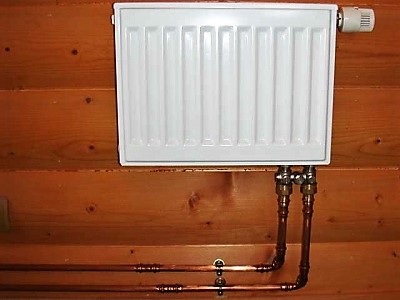
- Very good heat dissipation, which achieved in two ways — convection (in the case of panel radiators) and heating of the air in the room.
- Steel models have simple design, so the risk of any part breaking is minimal.
- Ease of installation, which is conditioned by and light weight batteries.
- Steel radiators have more affordable cost, when compared with aluminum products.
- Just for designers. This point applies more specifically to tubular radiators.
As for disadvantages, then there are several of them:
- The main disadvantage is the impact corrosionThe thing is that when the water is drained from the batteries, the batteries start to rust from the inside.
- Steel radiators cannot withstand hydraulic shocks and pressure surges. All this will lead to a breakthrough of the batteries, because they are made using a welding method, i.e. they have seams.
- It often happens that the paint coating is peeling off from batteries under the influence of high temperatures.
Useful video
The video shows in detail how to install a steel panel radiator.
Conclusion
Having assessed all the parameters and technical data of steel radiators, one conclusion can be made - this is quite a good option, but for a house that has individual heating. The main parameters for choosing steel heaters are good heat output, as well as ease of installation and affordable cost. The risk of failure is minimal, and the service life is very long.







Comments
The radiators are equipped with so-called grilles on top of them; they can be easily removed and the radiators can be cleaned with a steam generator.
I recommend Italian ones. Quality, original design, high heat output.
Cast iron has not been used for a long time. It is cheaper, but the rubber bands are not reliable, so you will have to sort it out (additional charge).
Bimetallic - excellent heat transfer. Here the steel core is filled with aluminum alloy. It is not afraid of impacts and is not subject to corrosion.